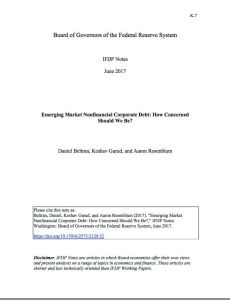Join getAbstract to access the summary!

Join getAbstract to access the summary!
Daniel Beltran, Keshav Garud and Aaron Rosenblum
Emerging Market Nonfinancial Corporate Debt
How Concerned Should We Be?
Federal Reserve Board, 2017
What's inside?
Corporate debt in the emerging economies has soared, but is it a threat to the rest of the world?
Recommendation
Some analysts believe that the growth of nonfinancial corporate (NFC) debt originating in the emerging markets could possibly result in global systemic contagion. Economists Daniel Beltran, Keshav Garud and Aaron Rosenblum dissect the issues surrounding NFC debt in the developing countries, which has skyrocketed since 2008. Although the authors don’t offer any solutions, they spin a convincing argument that the problem may not be as bad as it seems. getAbstract recommends this scholarly offering to executives, policy experts and financial professionals.
Summary
About the Authors
Daniel Beltran and Aaron Rosenblum are economists for the Board of Governors of the Federal Reserve System. Keshav Garud is a PhD student in economics at the University of Michigan.





















Comment on this summary